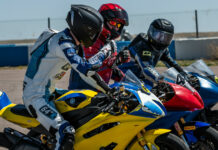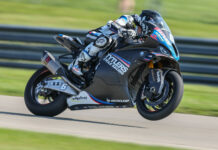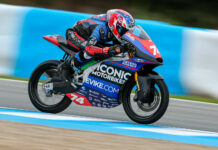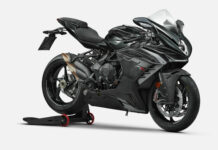GPRA West Coast Champion Peter Hofmann, 26, has landed a ride in the 125cc European Championship Series with Team Raudies, a team owned by 1993 125cc World Champion Dirk Raudies. Hofmann was recommended to Raudies–who himself didn’t start racing until he was 25 and who won his World Championship when he was 30–by Raudies’ former mechanic Uli Maier, a friend of the Hofmann family who worked with Hofmann throughout 2000 and who is now working for the Kawasaki World Superbike team. Hofmann will ride a Honda RS125 sponsored by the oil company Total, Daytona boots, Aeris.net, and most likely Bridgestone. Hofmann is Manager of Investment Analysis for Aeris.net and will commute between his home in San Jose, California and the team base in Munich; Hofmann says that his employer is being very supportive. Team Raudies is scheduled to start testing March 7-11 at Cartagena, followed by more tests March 19-21 at Mugello and April 13-15 at Hungaroring, with the European Championship season starting April 27-29 at Vallelunga in Rome, Italy. “It’s a dream come true,” said Hofmann. Hofmann was not an overnight success, and did not instantly attain his dream. He started racing mid-season 1992 on a Kawasaki Ninja 250R and raced the Kawasaki through 1993. He bought a 1989 RS125 and started the 1994 season on it, trading up to a new 1994 RS125 from Moto-Liberty halfway through the season. On that bike, Hofmann ran top-five and top-10 in AFM races in 1994 and 1995, competed in a few races in 1996 on the 1994 and on a subsequently acquired 1995 RS125 that had serious problems related to its previous owner’s tuning attempts, problems which lead to Hofmann crashing, hitting a wall at Sears Point and breaking his wrist. Hofmann didn’t race at all in 1997, because, he says now, “I wasn’t really serious about it.” Back up to 1994, and the U.S. Grand Prix at Laguna Seca. Peter, who has dual U.S.-German citizenship, and his German-born father, Otto, snuck into the pits after the races, walked up to Raudies and his team and started speaking to them in German. The Hofmanns offered to show the team around San Francisco during the few free days the team had before heading to the next GP, and friendships developed. After graduating from college in 1997, Hofmann went on vacation to Europe and attended the German Grand Prix at Nurburgring, where he again met with Raudies, and Hofmann’s interest in racing was rekindled. Hofmann took another run at racing in 1998 and 1999 on a 1998 RS125, but almost quit for good at the end of 1999, selling his bike and equipment. “I was discouraged because I was riding hard but not getting picked up by a team because nobody was watching the 125 class,” Hofmann said. “I was doing in it on all my own money and was always worried about crashing the bike and not being able to fix it.” Hofmann’s break came before the start of the 2000 season, when Chris Wallace put together Shakai Racing and signed Hofmann, which meant, to Hofmann, “I was able to just focus on racing, it didn’t matter if I crashed, all that mattered was that I won. The sponsors didn’t care if I trashed the equipment, all they wanted was wins. And I really thrived under that pressure.” Maier, who was looking for a break from the GP circus, agreed to move to the U.S. and tune for Hofmann for most of the 2000 season. Hofmann’s charge in the second race of the GPRA Final at Willow Springs–which saw Hofmann lead eventual GPRA National Champion Vicky Jackson-Bell before crashing–impressed Maier, who put in a good word with Raudies. Raudies, who has run riders in the European Championship since he personally retired from GP racing in 1997, agreed to back Hofmann for the 2001 season. Hofmann said, “You see the race tapes on TV and its looks so easy, but going fast on the track is an entirely different type of riding. The big change in my riding where I went from top five to consistently winning was due to an entirely different mind set. It was when I really made a mental connection to how I broke down the racetrack, breaking each corner into five or seven parts, and what I was doing on the racetrack in each of those parts. What really made the difference was learning to think about my riding that way and it took a couple of years to learn to do that.”
Peter Hofmann Gets Ride In 125cc European Series With Team Raudies, Proving That A 26-year-old Privateer Can Live The Dream
Peter Hofmann Gets Ride In 125cc European Series With Team Raudies, Proving That A 26-year-old Privateer Can Live The Dream
© 2001, Roadracing World Publishing, Inc.






